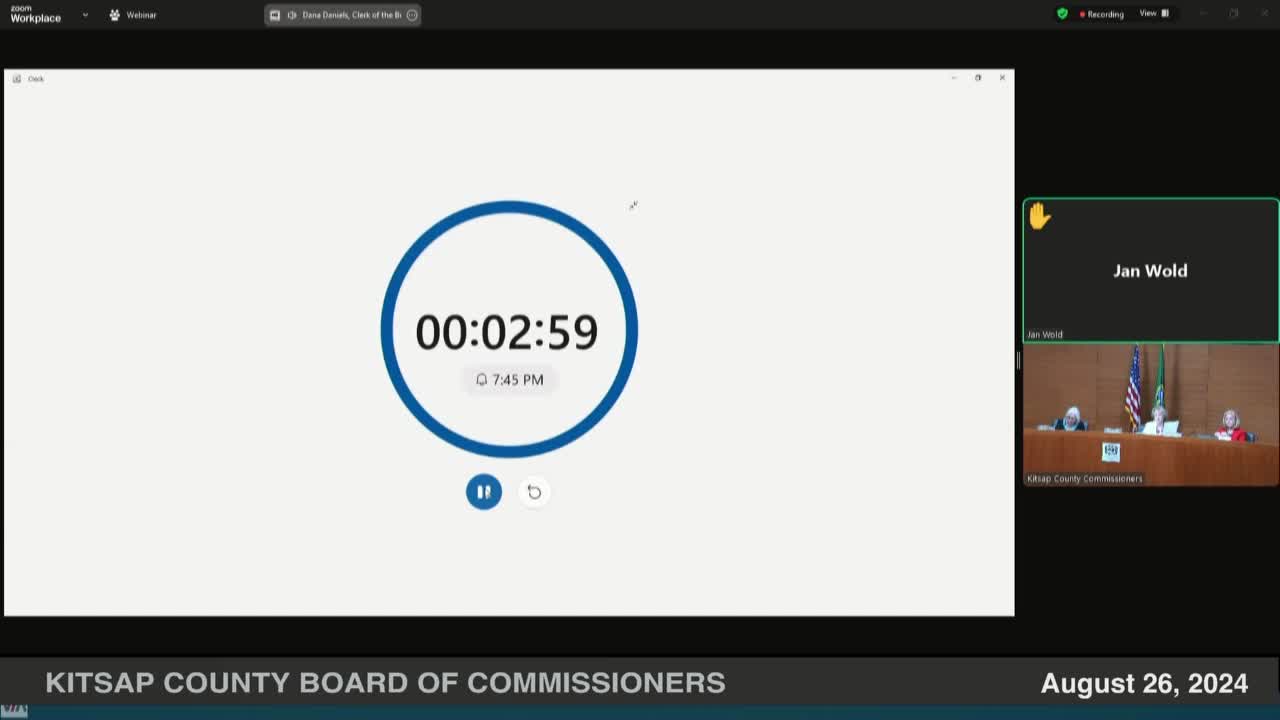Kitsap County residents demand stronger protections for wildlife corridors
August 26, 2024 | Kitsap County, Washington
This article was created by AI summarizing key points discussed. AI makes mistakes, so for full details and context, please refer to the video of the full meeting. Please report any errors so we can fix them. Report an error »

During a recent government meeting, community members voiced urgent concerns regarding the preservation of Kitsap County's critical environmental areas, particularly focusing on the degradation of local streams and wildlife habitats. The discussions highlighted the need for stronger regulations to protect salmon runs and other aquatic life, as well as the importance of maintaining adequate buffer zones around wetlands and streams.
A retired forestry supervisor emphasized the alarming decline of salmon populations in Kitsap streams, advocating for increased buffer sizes to mitigate habitat loss. He pointed out that the current 35-foot buffer width is insufficient and called for the identification of wider wildlife corridors on county maps to facilitate conservation efforts. This sentiment was echoed by several speakers who stressed the necessity of preserving these corridors to ensure the survival of local wildlife.
Thomas Doty raised concerns about the protection of amphibian habitats, noting that recent legal changes have left many breeding ponds vulnerable. He urged the county to declare these areas as critical to safeguard the local frog and salamander populations. Similarly, Robin Salthouse highlighted the need for robust enforcement of the Critical Area Ordinance (CAO) to prevent buffer reductions without public hearings, which could exacerbate the impacts of development on groundwater and biodiversity.
Dawn Finton pointed out that the proposed CAO updates inadequately address groundwater recharge, a critical issue as climate change alters rainfall patterns. She called for hydrogeological studies to assess the impact of large residential developments on aquifer recharge areas.
Beth Nichols and Doug Hayman both emphasized the importance of maintaining undisturbed buffers to protect water quality and ecosystem health. Nichols criticized the practice of allowing buffer reductions through variances, while Hayman suggested extending the deadline for CAO updates to ensure thorough consideration of best practices in environmental protection.
The Hood Canal Environmental Council expressed support for the proposed amendments to the CAO, advocating for the inclusion of travel corridors for all species and the protection of significant trees. Community members underscored the need for a collaborative approach to conservation, urging the county to prioritize the preservation of critical habitats to avoid costly restoration efforts in the future.
As the meeting concluded, the collective message from residents was clear: proactive measures are essential to safeguard Kitsap County's natural resources and ensure the sustainability of its ecosystems for future generations.
A retired forestry supervisor emphasized the alarming decline of salmon populations in Kitsap streams, advocating for increased buffer sizes to mitigate habitat loss. He pointed out that the current 35-foot buffer width is insufficient and called for the identification of wider wildlife corridors on county maps to facilitate conservation efforts. This sentiment was echoed by several speakers who stressed the necessity of preserving these corridors to ensure the survival of local wildlife.
Thomas Doty raised concerns about the protection of amphibian habitats, noting that recent legal changes have left many breeding ponds vulnerable. He urged the county to declare these areas as critical to safeguard the local frog and salamander populations. Similarly, Robin Salthouse highlighted the need for robust enforcement of the Critical Area Ordinance (CAO) to prevent buffer reductions without public hearings, which could exacerbate the impacts of development on groundwater and biodiversity.
Dawn Finton pointed out that the proposed CAO updates inadequately address groundwater recharge, a critical issue as climate change alters rainfall patterns. She called for hydrogeological studies to assess the impact of large residential developments on aquifer recharge areas.
Beth Nichols and Doug Hayman both emphasized the importance of maintaining undisturbed buffers to protect water quality and ecosystem health. Nichols criticized the practice of allowing buffer reductions through variances, while Hayman suggested extending the deadline for CAO updates to ensure thorough consideration of best practices in environmental protection.
The Hood Canal Environmental Council expressed support for the proposed amendments to the CAO, advocating for the inclusion of travel corridors for all species and the protection of significant trees. Community members underscored the need for a collaborative approach to conservation, urging the county to prioritize the preservation of critical habitats to avoid costly restoration efforts in the future.
As the meeting concluded, the collective message from residents was clear: proactive measures are essential to safeguard Kitsap County's natural resources and ensure the sustainability of its ecosystems for future generations.
View full meeting
This article is based on a recent meeting—watch the full video and explore the complete transcript for deeper insights into the discussion.
View full meeting
